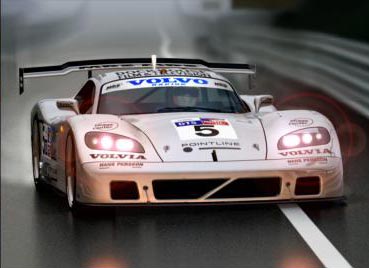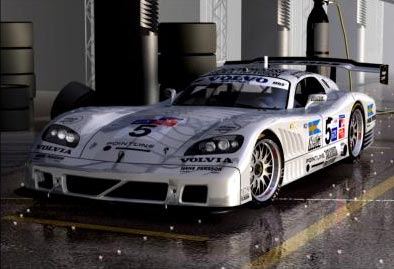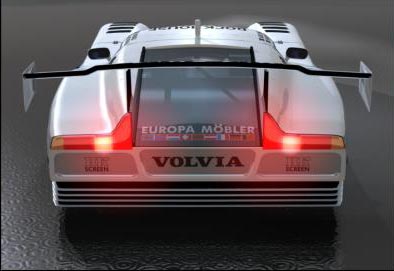 A fantastic new Volvo was unveiled on March 25 when the Swedish auto magazine Auto Motor and Sport scooped the motoring world with the latest vehicle to carry the Volvo badge.
A fantastic new Volvo was unveiled on March 25 when the Swedish auto magazine Auto Motor and Sport scooped the motoring world with the latest vehicle to carry the Volvo badge.
Currently known by its project code name "SE," the new and stunning Volvo reveals a new direction and something of a poignant irony for a company whose founders, Assar Gabrielson and Gustav Larson, saw no value in auto racing.
Yes, you've got it right: Volvo is slated to campaign two SE cars in the 2003 24 Heures du LeMans -- and unless you subscribe to Auto Motor and Sport, you read it here first.
As a member of Ford's Premier Automotive Group, Volvo Cars now has access to the resources and technology that until recently had been outside the safety focus they have built their 75-year-old reputation on. Ford Motor Company's president Bill Ford stated in a recent interview that while the parent company was restructuring to create a better state of efficiency, "There is still room in our company to produce cars that people will refer to with a sense of awe. The recent go-ahead given to our new GT40 product is consistent with this part of our mission. When word of the SE came to me, I was at first concerned that it would fly in the face of convention, which no doubt it will, but I am also aware that while Volvo built itself upon consistently being pioneers in safety technology, there is also a burgeoning pocket of die-hard racers that campaign modified Volvos in ways that both amaze and impress me." Ford then went on briefly to suggest that if the SE project is a success, there is already a privately prefabricated racing heritage courtesy of those people racing production Volvos.
A select team of engineers, designers and fabricators have endured the stark and often very harsh winters at a facility in Kiruna, near the Arctic circle in the northern most reaches of Sweden, for the previous 17 months in order to focus on the SE project without the prying eyes of both the public and the media.  The first chassis was tested last July and once the bugs were worked out, the nod was given to produce a second one. Precious little statistical information has been made available about construction or geometry of these frames. Even Auto Motor and Sport was not permitted to see the engine when viewing the now fully-clothed second chassis. This hush-hush attitude scotched any possibility that anyone outside the team would know anything significant about the chassis.
The first chassis was tested last July and once the bugs were worked out, the nod was given to produce a second one. Precious little statistical information has been made available about construction or geometry of these frames. Even Auto Motor and Sport was not permitted to see the engine when viewing the now fully-clothed second chassis. This hush-hush attitude scotched any possibility that anyone outside the team would know anything significant about the chassis.
A small group of writers from the motoring press became even more suspicious about the chassis design and construction when they were finally allowed to view the engine. It was presented to them on a stand in a dyno room at Volvo's development lab in Eskilstuna three days after the car's debut and performance at a testing track. Eliminating the car from the presentation continues to foster high curiosity as to what the road gear is all about.
Yet another milestone in the history of the company was noted as we realized we were looking at Volvo's first V12. The right side cylinder head looks reminiscent of the B6300 twin-cam straight six last used in the 960. The new plant boasts four cams, 48 valves and, depending on the results of testing, will use either two or four turbochargers. We viewed the Turbo Quartet version whose little snail-shells looked rather like ones used on the S80. The engine appears to be fascinating combination of off-the-shelf components and cubic money. The engineer functioning as our host, while asking not to be named, conceded that the right cylinder head looked like that of a 960 since that was essentially what it was. The left head was, of course a new casting, but based on the right-hand one, reversing the position of the cams, the intake and exhaust manifolds and the porting. Our host was rather coy about the divulging too much despite the barrage of questions hurled at him by the press. Yes, the engineering staff involved with the finishing touches on the Aston Martin Vanquish had been involved here. No, the engine has nothing in common with the current  line of modular engines offered in the Ford line-up. "Not sure" was his response when pressed to say whether the public would be offered engines derived from this exercise. The same response was offered when asked how many cars would be built.
line of modular engines offered in the Ford line-up. "Not sure" was his response when pressed to say whether the public would be offered engines derived from this exercise. The same response was offered when asked how many cars would be built.
The lines of the car are like nothing ever seen previously carrying a Volvo badge, and yet when you look at the body, you somehow know just what you're looking at. Granted the trademarked diagonal strake in the front air intake is a dead giveaway if nothing else up front could help clue you, but the rear end, with it's contours evoking those of the S80, make it very clear that this could be nothing else. To be sure, much of what you see is there strictly for competition purposes.
Yet there is another miracle to reveal, secrets notwithstanding: Under the watchful eye of Volvo's Design Chief Peter Horbury, ace designer Sune Envall conceived and perfected the body design in an astonishing 14 days. In an earlier brief chat, Envall modestly shrugged the achievement off with distracting claims that his favorite chef had been put on retainer and sequestered in Kiruna to ply him with his favorite Thai dishes, and that his drawing board and computer were placed in a room adjacent to his living quarters.
I later had another chance meeting in the airport at Gothenburg with Envall, who was exiting a plane as I waited for my return flight to the states. Seeing him and hoping for any further news on the SE project, he uttered a terse "No Comment" in response to my question as he brushed past me in a hurry. Perhaps it was a bad flight? Bewildered, I watched him continue away at a hurried pace when suddenly he turned to face me with a broad grin and exclaimed in English far better than my Swedish: "April Fools!"
